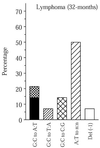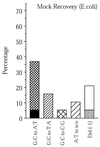Mutational fingerprints of aging
- PMID: 11788717
- PMCID: PMC99828
- DOI: 10.1093/nar/30.2.545
Mutational fingerprints of aging
Abstract
Using a lacZ plasmid transgenic mouse model, spectra of spontaneous point mutations were determined in brain, heart, liver, spleen and small intestine in young and old mice. While similar at a young age, the mutation spectra among these organs were significantly different in old age. In brain and heart G:C-->A:T transitions at CpG sites were the predominant mutation, suggesting that oxidative damage is not a major mutagenic event in these tissues. Other base changes, especially those affecting A:T base pairs, positively correlated with increasing proliferative activity of the different tissues. A relatively high percentage of base changes at A:T base pairs and compound mutants were found in both spleen and spontaneous lymphoma, suggesting a possible role of the hypermutation process in splenocytes in carcinogenesis. The similar mutant spectra observed at a young age may reflect a common mutation mechanism for all tissues that could be driven by the rapid cell division that takes place during development. However, the spectra of the young tissues did not resemble that of the most proliferative aged tissue, implying that replicative history per se is not the underlying causal factor of age-related organ-specific differences in mutation spectra. Rather, differences in organ function, possibly in association with replicative history, may explain the divergence in mutation spectra during aging.
Figures



References
-
- Vijg J. (2000) Somatic mutations and aging: a re-evaluation. Mutat. Res., 447, 117–135. - PubMed
-
- DePinho R.A. (2000) The age of cancer. Nature, 408, 248–254. - PubMed
-
- Boerrigter M.E.T.I., Dollé,M.E.T., Martus,H.-J., Gossen,J.A. and Vijg,J. (1995) Plasmid-based transgenic mouse model for studying in vivo mutations. Nature, 377, 657–659. - PubMed
-
- Dollé M.E.T., Giese,H., Hopkins,C.L., Martus,H.-J., Hausdorff,J.M. and Vijg,J. (1997) Rapid accumulation of genome rearrangements in liver but not in brain of old mice. Nature Genet., 17, 431–434. - PubMed
Publication types
MeSH terms
Grants and funding
LinkOut - more resources
Full Text Sources
Medical

